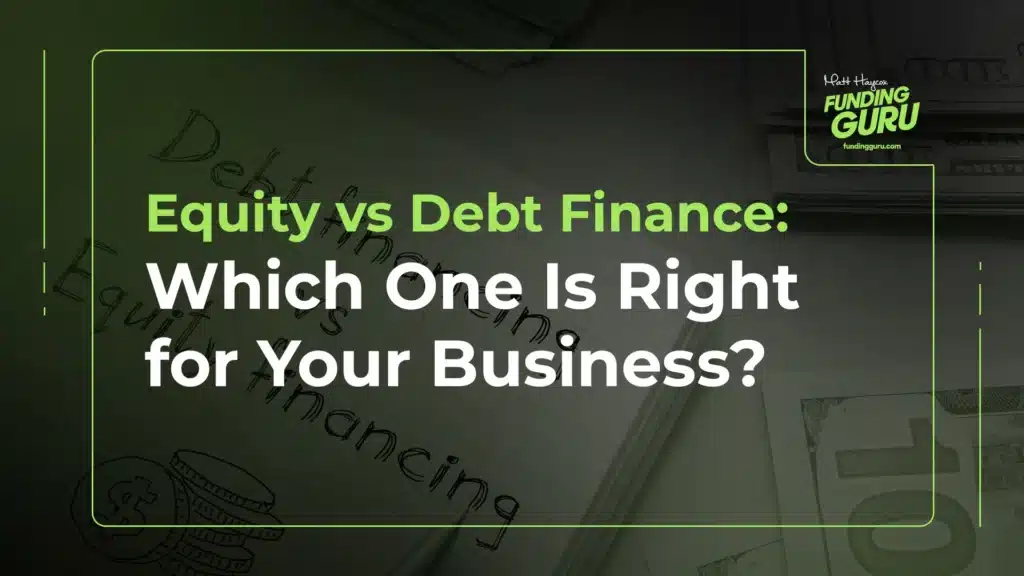Every growing business hits a point where funding becomes essential. Almost every scenario, even roaring success and rocketing sales, means you need to raise capital to get your business to the next stage. Whether you need to scale operations, invest in marketing, hire talent or develop new products, it’s almost impossible to do without additional funding. Even Jeff Bezos secured multiple rounds of funding during the early days of Amazon and Elon Musk received financial backing from his parents.
Two of the most common funding routes are equity financing and debt financing. Each has its own advantages, trade-offs and long-term implications. And which is right for you depends on what you want for the future of your business. One involves retaining complete control of your company and steady repayments and the other involves bringing in valuable strategic partners and giving up a share of your future profits.
So, which one do you think would benefit your business the most? If you’re not sure, this article aims to give you all the information you’ll need to make your decision. We’ll break down the differences between debt vs equity financing, outline the pros and cons of each and help you decide which route best fits your business goals.
Understanding Debt Financing vs Equity Financing
When it comes to debt vs equity financing, you need to make sure you have a clear understanding of the basics before you consider the pros, cons and strategies involved with each option.
What is Debt Financing?
Debt financing is when a business borrows money that must be repaid over time with interest. This timeframe will be agreed, but is usually between 1 and 25 years, depending on whether it’s a short- or long-term loan. The arrangement can be made with banks, private lenders, government-backed schemes or alternative finance providers.
Common types include:
- Business loans
- Overdraft facilities
- Invoice financing
- Asset-backed loans
The most attractive feature is that you retain full ownership of your business, but take on a repayment obligation. That means, if you can’t meet this obligation, you may have assets seized, depending on whether collateral was agreed as part of a secured agreement.
What is Equity Financing?
Equity financing means raising capital by selling shares in your company to investors, such as angel investors, venture capital firms or equity crowdfunding platforms. If you’re fairly new to the business world, this is basically the sort of financing they offer on TV shows like Dragon’s Den and Shark Tank.
You don’t need to repay this money. Not in the traditional loan sense, at least. Instead, you give up a portion of ownership and future profits. Investors may also want influence in key decisions depending on their stake. This means, if your business’ finances struggle, you don’t have any loan repayments to default on. But on the flip side, if your business soars, your investors will do exceptionally well from a financial standpoint because they’ll take a share of that success.
Side-by-Side Comparison: Debt vs Equity Financing
Here’s a quick comparison to help you visualise the key differences:
| Feature | Debt financing | Equity financing |
| Ownership | You retain 100% ownership | You sell a percentage of your business |
| Repayment | Fixed repayments with interest | No monthly repayments required |
| Cost | Interest charges | Share of profits/dividends |
| Speed of access | Typically quite fast | Slow, requires outreach and due diligence |
| Risk | Higher short-term risk with repayment pressures | Lower short-term risk but long-term dilution |
| Credit impact | Impacts credit score | No direct credit impact |
| Support/expertise | None | Guidance from experienced investors |
Pros and Cons of Debt Finance
Debt financing is ideal for businesses with stable cash flow, clear insight into projects and their financial future, and thorough revenue models.
Pros of Debt Finance
- Retain full ownership: You don’t give away any part of your business.
- Predictable repayments: Fixed schedules make budgeting easier.
- Faster access (in many cases): Especially with short-term loans or fintech lenders.
- Tax deductible interest: In most areas, interest payments can reduce taxable income.
Cons of Debt Finance
- Repayment pressure: Missed payments can hurt your credit score or result in legal action or seized assets.
- Collateral or guarantees: Some loans may require business or personal assets as security.
- Limited flexibility: Lenders may impose restrictions on how funds are used.
- Not always accessible for startups: Especially those with little trading history, no collateral or poor credit.
Real-World Example:
Subway is a household name, with more than 37,000 locations worldwide. But when it started in 1965, businessman Fred DeLuca took out a $1,000 loan to help him set up his first sandwich shop. Yes, the loan was from a family friend, but it was the support DeLuca needed to establish his business and paid off in spades.
Pros and Cons of Equity Finance
Equity finance is a great option for startups with big ambitions but limited cash flow.
Pros of Equity Finance
- No repayments: Great for early-stage or pre-revenue businesses that can’t afford monthly repayments.
- Strategic support: Investors often bring networks, expertise and mentorship in addition to more cash.
- Shared risk: If the business struggles, you don’t owe investors their money back.
- Better for long-term growth: Ideal for businesses that want to reinvest earnings rather than make repayments.
Cons of Equity Finance
- Loss of ownership and control: Even minority investors may request decision-making power or board seats.
- Dilution: Future funding rounds reduce your stake further.
- Slower process: Fundraising can take months and involve pitching, due diligence and negotiations.
- Pressure to scale fast: Equity investors typically seek high growth and an exit (e.g. acquisition or IPO).
Real-World Example:
UK-based bank Monzo raised equity investment from venture capital firms and equity crowdfunding, which it continues to do as it grows. Raising funds in this way has allowed them to scale rapidly, but involves multiple funding rounds and shareholder dilution.
How to Choose the Right Financing for Your Business
There’s no one-size-fits-all answer to which financing option is right for your business. The best choice depends on so many things that are unique to you, such as your goals, stage of growth, openness to risk and current and future financial status.
Here are several key factors to consider that should influence your decision:
1. Cash Flow Health
- Choose debt if you have regular, predictable revenue that can support repayments. This helps you retain complete control over your business, allowing you to keep your profits as you grow.
- Choose equity if you’re pre-revenue or want to invest heavily before generating returns.
2. Growth Ambitions
- Debt is more suitable for steady-growth businesses that want to maintain control.
- Equity is better suited to businesses aiming for rapid, exponential growth in a high-demand market.
3. Control vs Speed
- Need to move fast? Debt might be quicker to access in the short term.
- Not worried about control and would benefit from guidance and input from an experienced, business-building mentor? Equity isn’t the fastest, but it gives you both a major funding injection and insights from someone who’s been there and done that.
4. Risk Tolerance
- Debt comes with financial risk, with monthly repayments and high interest, which can lead to difficulties if you struggle to meet your obligations.
- Equity carries strategic risk, such as a loss of autonomy and pressure to exit, which can lead to frustrations if there are disagreements.
5. Stage of Business
- Established SMEs may prefer debt to avoid dilution.
- Startups often lean toward equity because they’re pre-revenue.
Hybrid Approach: A Blended Model
While debt and equity are two very distinct financing options, you don’t always have to choose one over the other. There is a third option that combines the two, which itself makes for an attractive option that can be used as your business grows. It’s becoming more and more common for growing businesses to use a hybrid model, combining both equity and debt finance. For example:
- Raise equity early to fuel product development and team growth.
- Use debt later for working capital or marketing once revenue is coming in.
This blended strategy allows you to maximise resources without overleveraging or over-diluting. It also appeals to later-stage investors who want to see capital efficiency and financial discipline, and have the confidence that what they’re investing in is low risk, high reward.
Conclusion
When it comes to securing funds for your business, who comes out on top for you between debt financing vs equity financing? Choosing between the two can be tricky as both have their pros and cons. Plus, both will have a massive impact on your business, not just from a financial point of view, but from a future operational and ownership point of view. Get it right, and you set your company on a path to sustainable growth. Get it wrong, and you could face ownership regret, financial pressure, or slower progress.
This might sound a little intimidating, but unfortunately, many business decisions are. And the thing is, there isn’t a right answer, only what’s right for you and your business as you take steps towards your goals.
If you’re excited to grow your business and want to make the next step towards financial success, speak to one of our advisors and get personalised guidance on your equity finance options today.



